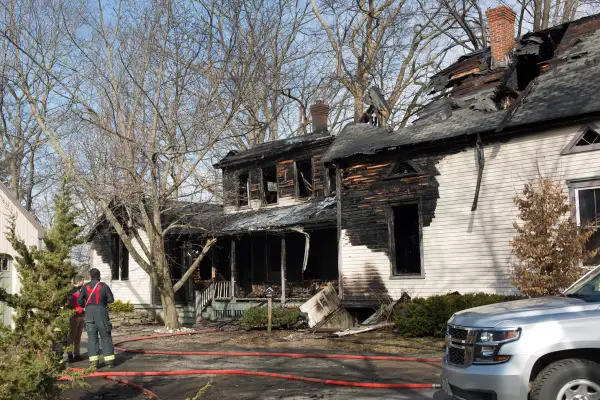If Disaster Strikes, Your Home Insurance May Not Cover the Cost of Rebuilding

You carry homeowners insurance to pay the costs if your home is damaged or destroyed. But not every policy guarantees you’ll be made whole after that happens, especially in a year like 2021.
The potential threat to full coverage begins with insurance that deducts from claims any depreciation on your home’s components -- as the least expensive home insurance does. If you have such a policy, you could be left short on rebuilding costs if, say, your roof was on its last legs or your kitchen was last replaced in the 20th century.
The solution? Be sure you have a policy that offers replacement cost, rather than a depreciated payout, if the worst happens to your home. Such coverage is especially valuable when the cost of building commodities is spiking -- as several have been doing lately -- or the demands of disasters like wildfires and hurricanes threaten to overheat wages for rebuilders.
“We've seen several claims where it’s cost a lot more to rebuild a home than originally estimated,” says Bob Buckel, vice president and product manager at Erie Insurance. “You have to think about the costs of material and labor.”
Increased demand and inflationary pressures have hiked prices for commodities like lumber, steel and copper, although National Association of Home Builders chairman Chuck Fowke said lumber prices have begun to come down in recent weeks.
Meanwhile, the wildfire and hurricane seasons loom, and both are predicted to be worse than usual, according to the National Interagency Fire Center and National Oceanic and Atmospheric Administration, respectively. That could lead to higher-than-normal repair costs in regions like the West and Southeast.
The upshot: now’s the time to check your home insurance policy, and consider upgrading it as needed -- to one of two levels of replacement-cost coverage. Here’s how to do that.
Basic replacement cost policies
Nothing requires you to carry homeowners insurance that covers replacement costs. Even if you have a mortgage on the property, the lender will probably require only an actual cash value (sometimes abbreviated as ACV) policy -- that is, one in which depreciation is factored in to reduce claims.
With such coverage, you’re insured for less than the full replacement value of your home. That flaw is why most insurance experts advise homeowners to get a replacement cost policy, which won't ding you for depreciation. But the least-expensive replacement cost coverage can still leave you short on a claim, particularly if a disaster renders the home a total loss, and the cost to rebuild is higher than the policy’s coverage limit.
Known as extended replacement cost coverage (or sometimes “additional replacement cost” or “enhanced replacement cost” coverage), this insurance allows claims up to the home’s insured value, plus an additional percentage of that figure, in case the insured value alone isn’t enough to cover the work.
“For example, if the policy shows $200,000 of coverage for the dwelling, a company may offer extended replacement cost that says they will pay up to 125% of the coverage limit,” Buckel says. “So in that case, the customer could get up to $250,000 to rebuild the home.”
Depending on the policy, the coverage boost usually ranges from 25% to 50%, although Nancy Albanese, vice president of personal insurance at BMT Insurance Advisors, says some insurance companies will go as high as 100% -- that is, to double the insured value on the policy.
Naturally, this coverage costs more than standard, actual-cash-value insurance. Albanese says it can run up to 10% higher than a standard policy, while insurer Hippo says you can expect to pay “upwards of $50 extra a year” for the upgrade.
Ultimate replacement cost coverage
There’s an even-higher level of replacement-cost protection than adding a percentage to the insured value of your home. Guaranteed replacement cost policies ensure your home will be restored to as close to its original condition as possible, without regard for cost. ‘You’re guaranteed to get the house you had. There’s really no worry for the policyholder that their home will not be rebuilt to its exact specifications,” Albanese says.
“We had a recent total loss claim in Pennsylvania where the home was insured for $203,000, and our estimate to rebuild it is $334,000,” Buckel says. Even a policy with a 25% or 50% extension to the insured value would have left the homeowner short by tens of thousands of dollars in covering the full cost of rebuilding. But “because the customer has ‘guaranteed’ replacement cost coverage, we will be paying that full amount to rebuild this home,” Buckel adds.
Such ample coverage comes at a price -- up to 10% more than extended replacement cost coverage policy, Buckel says. Albanese says the extra cost is often higher still, typically more like a 20% or 25% increase.
How to buy replacement cost coverage
When shopping for home insurance, it’s fairly easy to find a company to sell you extended or additional replacement cost coverage. Albanese says her agency represents “20-plus insurance carriers,” and nearly all offer this first level of coverage.
Not so for guaranteed replacement cost policies, which are offered by “only about six” of the companies whose policies Albanese sells -- fewer than a third of the total. More frequent wildfires and fiercer hurricanes have made this kind of insurance riskier for carriers to offer, Albanese says. Worse, she says, people with homes in places where disasters like these are common might not be able to get guaranteed replacement cost coverage at all.
The process for finalizing guaranteed replacement cost coverage can be complicated. A representative from the insurance company will probably need to visit the home in person. Insurers have tools for the policyholder or broker to input detailed metrics about the home to come up with an estimate of rebuilding costs.
“Many of the handful of companies that offer the guaranteed replacement cost are carriers that specialize in high-value homes,” Albanese says. “Those carriers almost always send out an appraiser to determine that the home is insured correctly.”
Depending on your insurance carrier, even extended coverage might entail a more in-depth process than for a ACV policy. “We use the same underwriting guidelines and approach for extended or additional replacement cost coverage as we do for guaranteed replacement cost coverage,” Buckel says. “Part of this is the expectation that our agents conduct an external inspection of the home before writing the insurance.”
Who should get replacement cost coverage?
If your home is currently insured only for its depreciation-reduced actual cash value, you should strongly consider upgrading to some form of replacement cost coverage. As national agency Marsh McLellan writes ”if you don’t insure to the full value of your home, you may find yourself responsible for a significant portion of the rebuilding costs in the event of a loss.” The agency also points out that extended replacement cost coverage may automatically accompany insuring your home to 100% of its value.
More debatable, due to its cost and scarcity, is whether you should take the next step to buying a guaranteed replacement cost policy. “It’s very good coverage, if available,” says Albanese of the insurance. “It can make a big difference, especially if there's a situation where there's a widespread disaster and building costs unexpectedly rise.” The policy add-on is especially important, she adds, if you live in an area with a high level of disaster risk, such as the Midwest’s “Tornado Alley,” hurricane-prone Southeast coastal areas or dry Western regions vulnerable to wildfires. (Keep in mind, though, that home insurance generally covers damage from wind and rain but not flooding, which requires separate flood insurance.)
Buckel concurs that guaranteed coverage is a wise buy for people living in high-disaster-risk regions, and also for those who live in older homes. It’s notoriously difficult for insurance appraisers and homeowners to correctly estimate the cost to rebuild a vintage property, he says. “You might need older materials, maybe things that aren't as commonly used, like brick or certain types of lumber — those tend to run higher than you would think to rebuild an older home.”
Buckel also says homeowners whose houses have expensive fixtures or finishes such as professional-grade kitchen appliances or granite-topped vanities should consider a guaranteed policy. Given the high cost of those luxuries, he says, a claim under lesser coverage could be problematic.
“The policy itself will say you get like materials. As long as there's enough coverage, that’s fine,” he says. “The problem is, if you put $20,000 into granite countertops, that’s included in your coverage limit. All of it adds up.”
Then come rising commodity costs. While some are forecast to abate -- like lumber prices — they offer additional incentive to upgrade to replacement cost for those who are already candidates for it. The impact of inflation on a per-project basis can be considerable; earlier this year, it was estimated that then-higher lumber prices could add nearly $36,000 to the cost of building a new home compared with typical years, according to the National Association of Home Builders.
More from Money:
Best Homeowners Insurance Companies of 2021
Hurricanes and Insurance: All Water Damage Isn’t the Same When It Comes to Coverage
Why You Should Consider Flood Insurance Even if You Don’t Live in a Flood Zone
